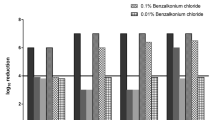Summary
Experiments were performed utilizing eight pathogenic microorganisms associated with polluted waters, including seven different bacteria and the yeast-like fungus, Candida albicans. Cultures of the organisms were added to sea water with varying salinities and were incubated at 4, 25 and 37°C for eleven days. Results indicated that only C. albicans was able to survive in the experimental environments for the duration of the test period, while no bacterial species was viable beyond nine days. The potential of C. albicans as a pollution indicator organism in marine environments is pointed out.
Resume
Survivance de certaines microbes pathogeniques dans les environs de l'eau de mer.
Des expériences ont été conduit en utilizant huit microorganismes pathogéniques qu'on trouve dans les eaux contaminées, sept bactéries différentes et le fungus Candida albicans inclus. Cultures des organismes étaient ajoutées aux d'eaux salée de salinitées diverses, et elles étaient couvées à 4°, 25°, et 37°C pendant une periode d'onze jours. Les résultats ont indiqué que seul C. albicans peuvant survivre dans les milieux expérimentaux pour la durée des expériences, tandis qu'aucune des bactéries était viable au dela de neuf jours. Le potentiel de C. albicans comme organisme indicateur de pollution dans les environs marins est traité.
Similar content being viewed by others
References
Buck, J. D. & Meyers, S. P. 1965. Antiyeast activity in the marine environment. Limnol. Oceanog. 10 (3): 385–391.
Carlucci, A. F. & Pramer, D. 1959. Factors affecting the survival of bacteria in sea water. Appl. Microbiol. 7: 388–392.
Coons, A. H., Creech, H. J. & Jones, R. N. 1941. Immunological properties of an antibody containing a fluorescent group. Proc. Soc. Exp. Biol. Med. 47: 200–202.
Dzawachiszwili, N., Landau, J. W., Newcomer, V. D. & Plunkett, O. A. 1964. The effect of sea water and sodium chloride on the growth of fungi pathogenic to man. J. Invest. Derm. 43: 103–109.
Jannasch, H. W. 1968. Competitive elimination of enterobacteriaceae from seawater. App. Microbiol. 16: 1616–1618.
Jones, G. E. 1963. Suppression of bacterial growth by sea water. In Symposium on Marine Microbiology: 572–579. Ed. Oppenheimer, C. C. C. Thomas Co., Springfield.
Ketchum, B. H., Ayers, J. D. & Vaccaro, R. F. 1952. Processes contributing to the decrease of coliform bacteria in a tidal estuary. Ecology 33: 247–258.
Madri: P. P. 1968. Factors influencing growth and morphology of Candida albicans in a marine environment. Bot. Marine 11 (−9):31–35.
Orlob, G. T. 1956. Viability of sewage bacteria in sea water. Sewage Ind. Wates 28: 1147–1167.
Pramer, D., Carlucci, A. F. & Scarpino, P. V. 1963. The bacterial action of sea water. In Symposium on Marine Microbiology: 567–571. Ed. Oppenheimer, C. C. C. Thomas Co., Springfield.
Savage, H. P. & Hanes, N. B. 1971. Toxicity of seawater to coliform bacteria. J. Water Pollution Comr. Fed. 4 (5): 855–861.
Author information
Authors and Affiliations
Rights and permissions
About this article
Cite this article
Jamieson, W., Madri, P. & Claus, G. Survival of certain pathogenic microorganisms in sea water. Hydrobiologia 50, 117–121 (1976). https://doi.org/10.1007/BF00019814
Revised:
Issue Date:
DOI: https://doi.org/10.1007/BF00019814




